Integration of renewable energy sources into the energy system


· 15 min read
The increasing share of wind and solar generation in the power mix of many countries and regions poses challenges for energy managers. How can the increasing share of variable energy flows be safely integrated into the grid with the least energy losses and without compromising system reliability?
Today, a large body of empirical data has accumulated on grid management in the context of a high share and even dominance of renewable energy sources. In addition, there is no shortage of theoretical studies and models of systems based on renewable energy sources.
At the same time, despite the abundance of data, the discussion of renewable energy integration is often accompanied by “misconceptions, myths, and even disinformation,” according to the International Energy Agency (IEA) in its guide Getting Wind and Sun onto the Grid, which was published in March this year.
This document describes solutions for optimally integrating variable solar and wind generation into the grid.
This is not the first IEA document on this topic. In 2014, the 238-page report “The Power of Transformation: Wind, Sun and the Economics of Flexible Power Systems” was published, which answered the question: can an energy system remain reliable and cost-effective if it contains a high share of variable renewable energy generation? And if so, how?
In 2016, the report “Next Generation Wind and Solar Power” was presented. The “next generation” that has arrived means technologically mature and commercially competitive renewable energy generation technologies. Their increasing prevalence creates challenges for energy systems due to the instability of generation. The work considers responses to these challenges, with specific examples from several countries.
I would like to point out that the IEA is a research center dealing with all sectors of the energy market, and is by no means a “mouthpiece for renewable energy”. In addition, the aforementioned reports were prepared under different heads of the Agency (“The Power of Transformation” under the previous head of the IEA, Maria van der Hoeven, and the other two under the current one, Fatih Birol). Therefore, their conclusions can be considered objectively neutral in comparison with the works published by “interested parties”.
This 2014 report summarizes the results of the IEA project “Grid Integration of VRE” (VRE — variable renewable energy), conducted in several countries.
Let’s look at its key findings.
Integrating small volumes of variable renewable energy into the grid is not a problem. By small volumes, we mean a share of 5–10%.
However, some rules must still be followed:
Avoid uncontrolled local concentrations of renewable energy (“hot spots”);
Ensure that renewable energy plants can “help” stabilize the grid when necessary;
Forecast renewable energy generation and use these forecasts to plan the operation of other power plants and electricity flows in the grid.
Research in the project regions showed that the current level of flexibility of energy systems technically allows “working” with an annual share of variable generation of 25–40%. According to the same analysis, “in very flexible systems” the share of RES can exceed 50% levels if forced shutdowns of “small volumes” of RES generation are allowed.
Integration of large volumes of RES requires a transformation of the energy system as a whole. In other words, it is not a matter of simply adding new generation facilities to the “old” system operating as usual, but of a complete reformatting of the system.
The costs associated with this transformation depend on various circumstances. If a high share of RES is added at one time (which generally does not happen), then the system costs increase significantly. On the other hand, with gradual development (taking into account the reduction in the cost of RES technologies and, conversely, the growth of environmental charges in the future), zero or even negative growth of system costs is possible.
“The key finding of this paper is that large shares of variable renewable energy (up to 45% of annual generation) can be integrated without significantly increasing system costs in the long term.”
The paper reiterates the obvious: integration costs, the system costs associated with adding a new source to it, are not specific to variable renewable energy (literally: “Integration costs are not specific to wind power or solar PV” — p. 70). Any power plant needs to be integrated into the system, and uncertainty in terms of output is inherent in any generating facility (breakdowns, interruptions in fuel supplies, etc.).
The IEA provides data from various studies on the size of the system costs arising from the variable nature of wind generation, the so-called balancing costs .
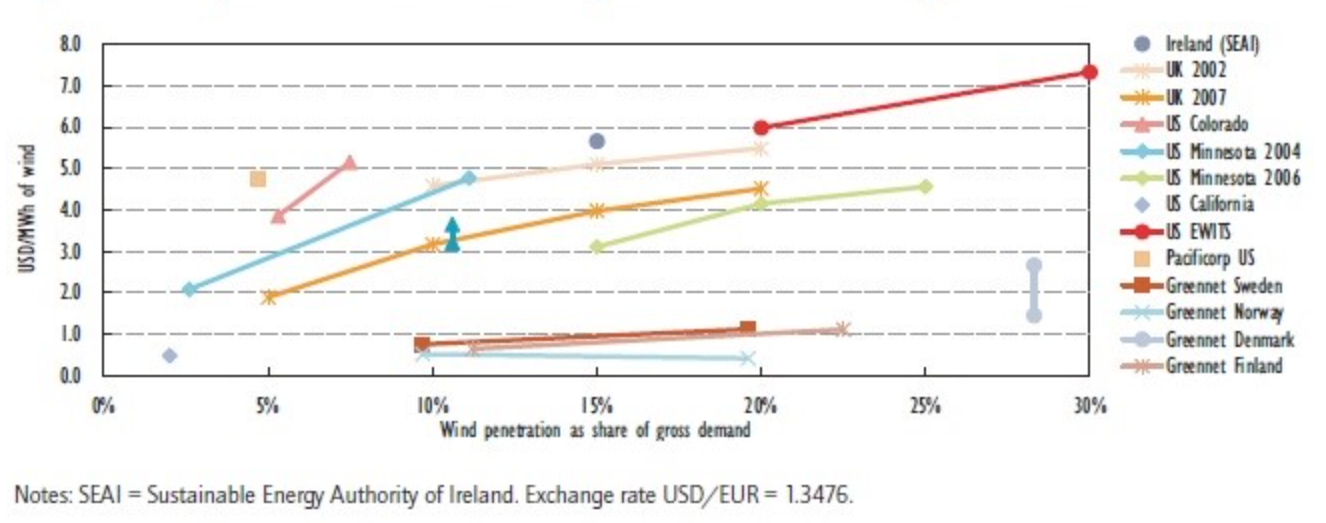
Comparison of modelled balancing costs from different integration studies
Source: Holttinen, H. et al., 2013
The size of these costs varies from 1 to 7 US dollars per megawatt-hour. In addition, the approach, which “simply” calculates integration costs, is not competent, according to the IEA. It is more correct to work with the “value” indicator (Value of VRE), that is, to take into account a wider range of effects (p. 81). The IEA directly advises “to avoid the methodological shortcomings of calculating the cost of integration and instead assess the overall efficiency of variable RES at the system level” (p. 189).
A separate insert in the work is devoted to the old myth called “Do variable renewables need backup capacity?” (pp. 74–75). “The term “backup capacity” is somewhat misleading,” the report says. “The presence of variable RES in the system does not mean that any additional adjustable (maneuverable) capacity needs to be built.” On the contrary, to the extent that RES adds capacity to the system (capacity credit), the need for other energy capacities decreases (RES capacity in the system increases with the expansion of the geography of power plants and the diversification of energy sources).
“The system as a whole requires sufficient capacity and energy. The latter contributes asymmetrically at high shares of variable generation based on RES—more energy than capacity. What is needed at the system level is not a backup for RES, but a cost-effective solution to meet the electricity demand. As a result, at high shares of RES, the remaining power plants must provide more capacity than electricity.”
This report is interesting primarily for its extensive overview of the practice of integrating renewable energy sources into the power systems of different countries, as well as the concept of the “system value” of different generation technologies.
The document argues that the traditional focus on the cost of electricity (LCOE) — measuring the costs of a specific generation technology at the power plant level — is insufficient today.
“Next generation” approaches require taking into account the “system value” (SV) of electricity produced by wind and solar. That is, the overall benefit obtained by adding solar or wind generation to the power system. This “system value” is determined by a combination of positive and negative factors, including lower fuel costs, reduced emissions of carbon dioxide and other pollutants, or higher costs for additional network infrastructure.
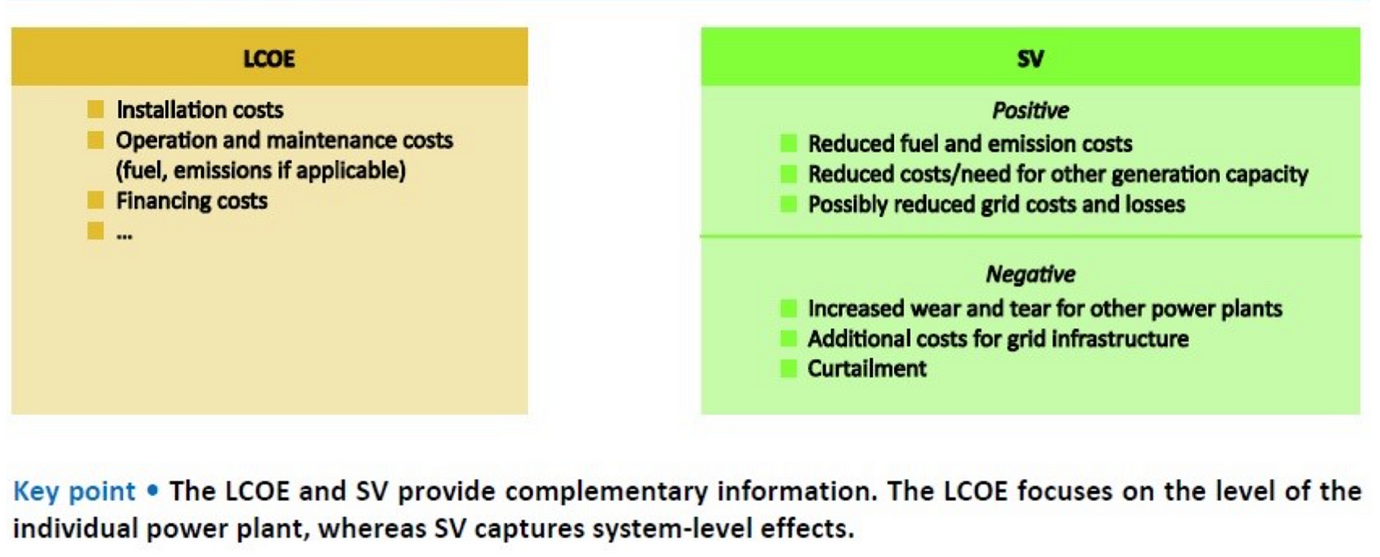
A comparison of LCOE and SV
The rapid expansion of solar and wind energy is a fact. A “new generation” of these types of generation is coming — technologically advanced and cost-effective.
With the increasing share of unstable generation based on solar and wind, a thorough systems approach to the transformation of the energy system becomes necessary.
This transformation can be “broken down” into three key elements:
“Painless” integration of variable RES for the system (see below);
Increasing the flexibility of the system through the use of appropriate “flexible technologies” (generation, energy storage, demand management);
Improving the technologies of the system’s operation (for example, improving the quality of forecasting generation based on RES).
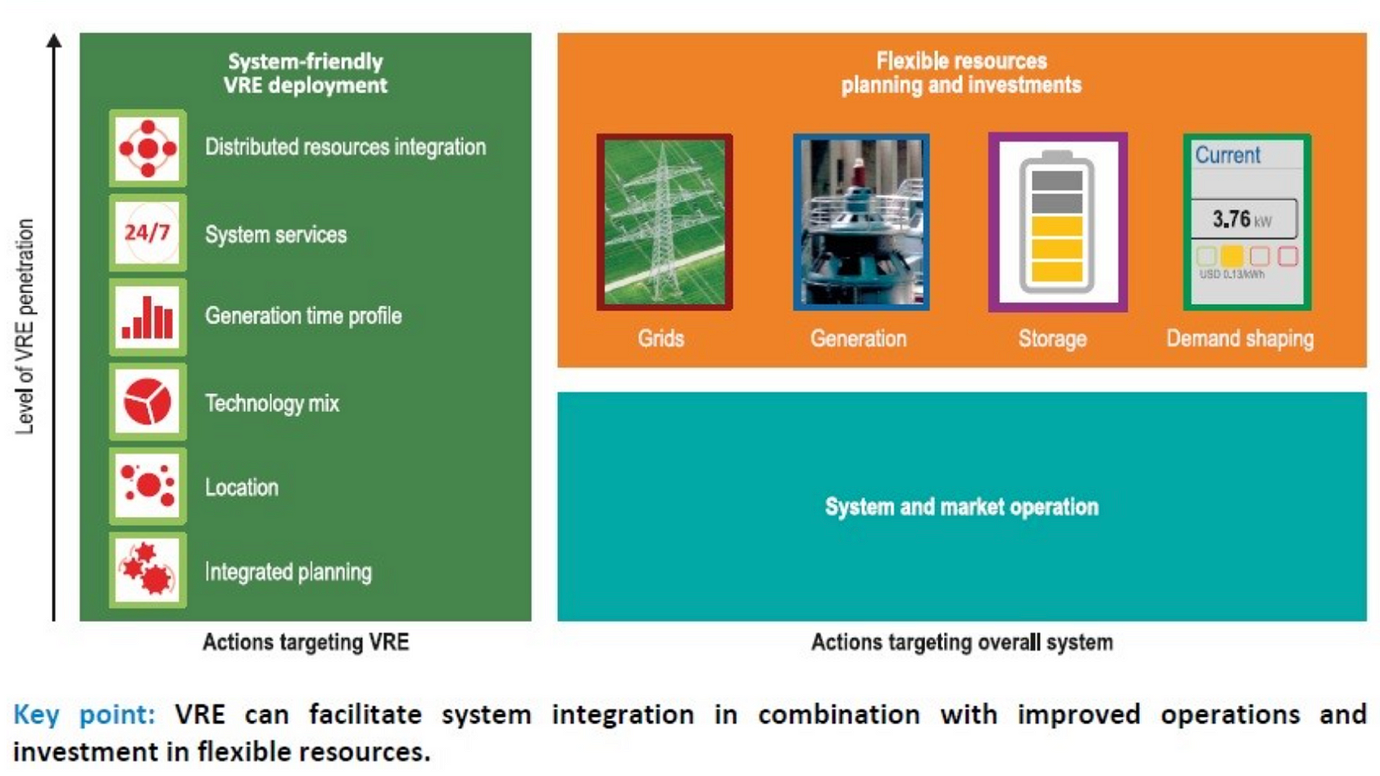
Three pillars of system transformation
Wind and solar energy can be “painlessly” integrated into the system using appropriate integration strategies.
In particular, six important areas/principles are highlighted:
Provision of system services by solar and wind power plants. This requires appropriate changes in the regulatory framework.
Deployment of renewable energy generation facilities in areas where they can provide greater system value (for example, closer to areas of highest demand).
Diversification of energy sources — mutual complementarity of solar and wind generation. Parallel development of hydropower (an example is given of Brazil, which is developing both wind power and new hydro resources).
Local integration with other resources. This involves increasing the share of own (local) energy consumption produced on-site, thanks to the use of a set (package) of solutions. For example, a combination of solar power plants with energy storage and the use of demand management mechanisms. This reduces the need for investment in distribution networks.
Optimization of the generation period. The design of wind and solar installations can be optimized to facilitate their integration into the grid. For example, using larger blades on a wind turbine with the same power reduces integration challenges because they produce electricity with greater stability. Detailed modeling within the IEA project showed that such a design produces electricity with a higher value for the system.
Integrated planning, monitoring, and control. The cost of different generation technologies and the electricity they produce change dynamically. Consequently, the optimal generation mix also changes over time, which requires regular adjustments to strategies.
The task of modern regulators, according to the IEA, is to create such framework conditions and rules for the energy market that could take into account the systemic value of projects and select them based on this criterion. Thus, a more expensive (in terms of LCOE) project may be preferable if it provides high value for the system.
Let’s now look at the most recent paper, Getting Wind and Sun onto the Grid, published in March 2017. This is a Manual for energy ministry officials and energy market regulators, as the IEA itself notes.
This manual focuses on the challenges of renewable energy integration. It provides examples of where and how these have been met and resolved and provides clear guidance on how newcomers should proceed in terms of developing intermittent renewable generation.
The paper considers four stages of intermittent renewable energy deployment, each with its specific characteristics. Recommendations are provided for each stage.
In the first stage, intermittent renewable energy integration has no noticeable impact on the grid. Intermittent generation from wind and solar power plants is “classified” here simply as daily and “natural” variations in electricity demand. Countries that are currently at this stage include Indonesia, South Africa, and Mexico, where the combined shares of solar and wind do not exceed approximately 3% of annual electricity production.
In the second stage, renewable energy sources are already beginning to have a significant impact on the system, but this impact is relatively easy to regulate by improving some practical methods of managing the electricity/grid economy, for example, by intelligently forecasting the output of solar and wind power plants. Chile, China, Brazil, India, New Zealand, Australia, the Netherlands, Sweden, Austria, and Belgium are at this stage, where the share of renewable energy sources in annual generation ranges from 3% to almost 15%.
In the third stage, significant challenges arise for the power system in terms of integrating unstable renewable energy sources. Their impact is felt both at the level of the system as a whole and in the practice of operating other (“traditional”) power plants. Here, the flexibility of the power system comes to the fore — its ability to respond to uncertainty and variability in the balance of supply and demand. The two main flexible resources of this stage are controllable (maneuverable) power plants and the grid, but the importance of demand response and new energy storage technologies is already beginning to increase. Currently, Italy, Great Britain, Greece, Spain, Portugal, and Germany are at this stage, where the share of “unstable” RES is from 15% to 25%.
Ireland and Denmark are at the fourth stage with a share of variable RES generation of 25%-50% of annual output and with short-term increases to 100% or more of daily consumption. Here, the challenges are, in IEA terms, “high-tech” and “less intuitive”. At the fourth stage, even greater system flexibility is required, its ability to self-recover after sharp and large fluctuations in output.
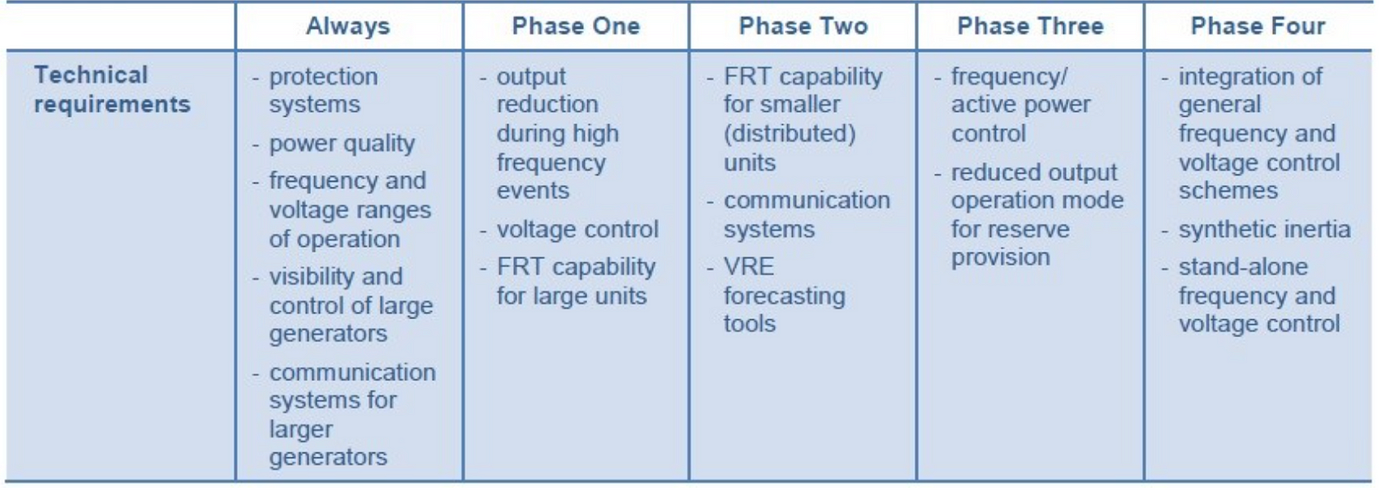
The technical requirements with the corresponding solutions for each stage
The IEA notes that development does not stop at the fourth stage. It is possible to distinguish the fifth and sixth stages, which are not considered in the work, and to which only brief characteristics are given.
For the rational distribution of renewable energy sources (VRE) in average annual volumes exceeding 50%, to avoid artificial restrictions on generation (and, accordingly, deterioration of thegeneration economy), electrification of other sectors of final energy consumption (heat supply, transport) is required.
In the conditions of total dominance of variable renewable energy sources (the sixth stage), it becomes necessary to convert electricity into chemicals (synthetic gases, for example, methane and hydrogen).
The work again examines common myths about renewable energy sources and their integration into the grid economy. The IEA makes a reservation, which, if applied to our realities, looks somewhat “satirical”. Its essence is that beginners tend to make mistakes since they have not yet gained enough experience to understand that they are mistaken.
In total, six common “claims” against renewable energy sources are considered here.
The weather cannot be controlled — the output of solar and wind power plants fluctuates too much and is not suitable for the electric power industry. These are easy-to-understand considerations for the layman, but they miss two factors. First, electricity demand always fluctuates. Therefore, energy systems already have mechanisms in place to cope with variability. When wind and solar power are just starting to develop, their fluctuations are “lost in the noise” of demand fluctuations. Second, as more and more renewable energy plants are added to the system, short-term fluctuations in output from plants located in different locations “compensate” each other. This means that variability becomes less pronounced, and major changes in output now typically occur on an hourly scale rather than a second scale.
Renewable energy variability forces other power plants to rethink their operating models, which leads to a sharp increase in system costs. This has been discussed earlier. Experience shows that traditional power plants are technically capable of more “flexible” operation without significantly increasing the overall cost of the energy system. Using RES generation forecasts and adjusting generation schedules in real-time are inexpensive and effective tools for mitigating adverse impacts. The question is in the ability and skill of energy market participants to implement and apply these tools.
The third point is again the 1:1 reservation, which has already been mentioned and which is loved by many “experts”.
“It is important to remember,” the Study says, “that energy systems are not designed to reserve a specific group of power plants.” The system as a whole must ensure that supply and demand are matched.
With the geographical distribution of RES-based generation facilities, that is, if many facilities appear in different places, the “capacity value” of RES increases. This means that the generation schedule becomes largely predictable, as shown in the figure from this report.
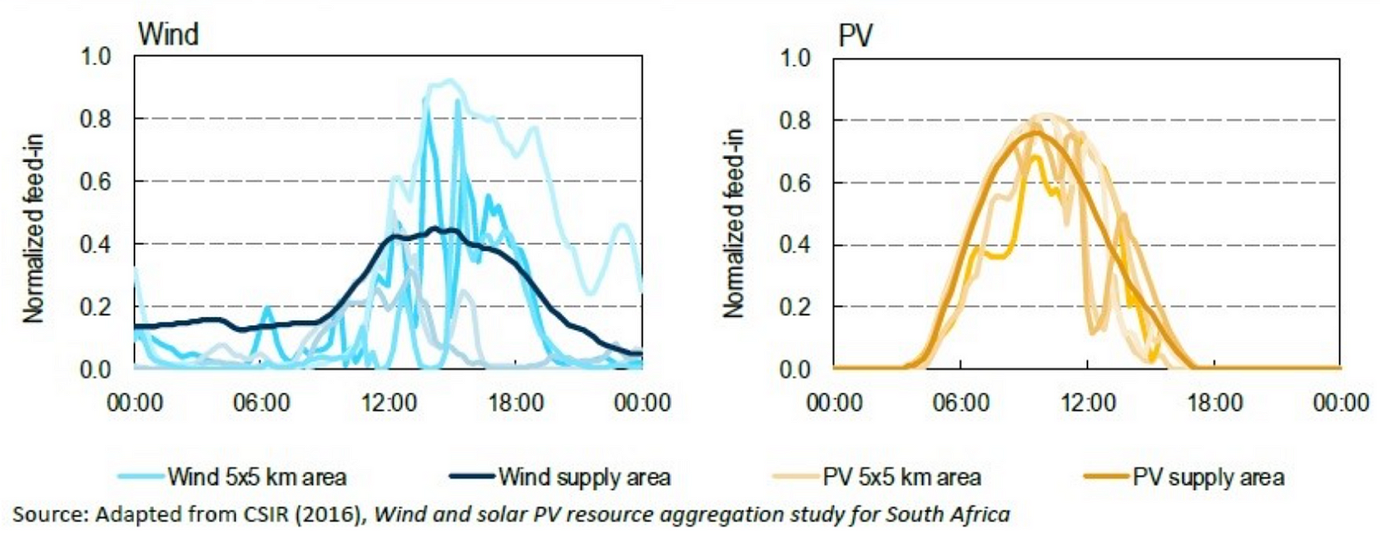
VRE output and the benefit of geo-spread
The high cost of developing a grid economy, because the best solar and wind resources are located far from the centers of electricity consumption. This is an argument from the past, and it should be discussed individually, about the situation of each energy system and individual facility. Current renewable energy technologies are rapidly becoming cheaper, so they can be used economically and rationally in places that are not the most favorable in terms of solar or wind resources.
Energy storage devices are necessary for the development of renewable energy sources. Storage devices are not needed at the initial stages of renewable energy development and with a branched and effectively managed grid economy. German experience (the 50 Hertz grid company) shows that networks with a share of variable renewable energy sources in electricity flows at the level of 50% per year can function normally without any additional storage devices. Storage devices are just one of the tools for increasing the flexibility of the energy system. It is possible to say that the system needs storage devices for its uninterrupted operation only for energy systems with an extremely high share of renewable energy sources, far exceeding 50%.
Variable renewable energy sources destabilize the energy system. Energy systems are among the most complex machines ever created by man. The work of system operators in ensuring the stability of the system is somewhat similar to riding a bicycle: you need to constantly steer to maintain balance.
Everyone knows that it is more difficult to maintain balance when moving slowly. The rotation of the wheels at high speed provides inertia, stabilizing the bicycle according to the laws of physics. A similar process occurs in energy systems: the operation of large generators and turbines at power plants provides inertia in the system and keeps it in balance. However solar and wind power plants work differently and do not provide inertia. This is the basis for this sixth claim.
At the initial stages of the development of renewable energy sources, this problem does not arise. If the share of traditional power plants in the system decreases, the inertia of the power system also decreases, so additional solutions are needed to ensure its stability. In conditions of a high share of renewable energy sources, technologically advanced solutions can be used, aimed at extracting the synthetic inertia of wind turbines or including the use of flywheels.
In addition, modern solar and wind power plants are so technically advanced that they can provide (auxiliary) system services to stabilize the grid economy. At the same time, it will take time to “polish” and legislatively accept these technological solutions.
The share of renewable energy sources in the global energy sector is growing, and this creates certain challenges for the management of the industry since solar and wind-based generation is “intermittent” and unpredictable.
At the same time, the issues of integrating unstable renewable energy sources into the energy system have been deeply studied and thoroughly worked out. A wealth of practical experience in using renewable energy sources in different countries has been accumulated and described. General principles for handling them have been compiled and formulated in detail.
Therefore, when discussing the prospects and issues of planning energy development, it is advisable to refer to this experience, which, among other things, is summarized in the documents of the International Energy Agency reviewed.
illuminem Voices is a democratic space presenting the thoughts and opinions of leading Sustainability & Energy writers, their opinions do not necessarily represent those of illuminem.
Alex Hong

Energy Transition · Energy
illuminem briefings

Hydrogen · Energy
illuminem briefings

Energy Transition · Energy Management & Efficiency
Financial Times

Power Grid · Power & Utilities
The Guardian

Natural Gas · Greenwashing
Politico

Solar · Public Governance